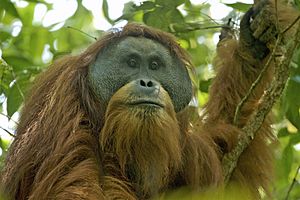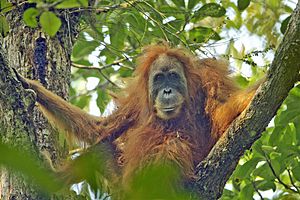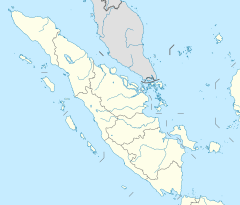Tapanuli orangutan facts for kids
Quick facts for kids Tapanuli orangutan |
|
|---|---|
 |
|
| Adult male | |
 |
|
| Adult female Both near Lake Toba |
|
| Conservation status | |
| Scientific classification | |
| Approximate location in Sumatra |
The Tapanuli orangutan (Pongo tapanuliensis) is a type of orangutan. It lives only in a small area called South Tapanuli on the island of Sumatra in Indonesia.
This orangutan is one of three known species. The others are the Sumatran orangutan (P. abelii), which lives further northwest, and the Bornean orangutan (P. pygmaeus). Scientists officially named the Tapanuli orangutan as a separate species in 2017. As of As of 2020[update], there are only about 800 of these orangutans left. This makes them a critically endangered animal.
Contents
Discovery and Naming
People first heard about a group of orangutans in the Batang Toru area of South Tapanuli in 1939. This group was found again by explorers in 1997. But at that time, no one realized they were a different species.
In 2017, scientists studied these orangutans very closely. They looked at the genes of 37 wild orangutans from Sumatra and Borneo. They also studied the body shapes of 34 adult male orangutan skeletons. This research showed that Pongo tapanuliensis was indeed a unique species.
The main skeleton used for this study was from an adult male Tapanuli orangutan. He died in November 2013 after being hurt by local people. This skeleton is kept at the Zoological Museum of Bogor. The skull and teeth of this male orangutan are very different from the other two orangutan species. The genetic studies also confirmed that the Batang Toru orangutans are a separate species.
The name tapanuliensis comes from Tapanuli. This is the hilly region in North Sumatra where these orangutans live.
Family Tree of Orangutans
Genetic studies show that Tapanuli orangutans separated from Sumatran orangutans about 3.4 million years ago. They became even more isolated after a huge volcano eruption at Lake Toba about 75,000 years ago. They had some contact after that, but it stopped completely between 10,000 and 20,000 years ago.
Tapanuli orangutans separated from Bornean orangutans about 674,000 years ago. In the past, orangutans could travel between Sumatra and Borneo. This was because the islands were connected by land bridges during ice ages. At those times, sea levels were much lower. Scientists think that the area where Tapanuli orangutans live today is close to where ancient orangutans first arrived in what is now Indonesia from mainland Asia.
Appearance and Features
Tapanuli orangutans look more like Sumatran orangutans than Bornean orangutans. They have similar body shapes and fur colors. However, Tapanuli orangutans have frizzier hair. They also have smaller heads and flatter, wider faces.
Adult male Tapanuli orangutans have big moustaches. They also have large, flat cheek pads called flanges, which are covered in soft hair. Both male and female Tapanuli orangutans have beards. With Bornean orangutans, only the males have beards.
The Tapanuli orangutan has several unique features that make it different from the other two orangutan species:
- Their upper canine teeth are larger.
- Their face is not as deep.
- They have a shorter tube connecting their ear to their throat.
- Their jaw joint is shorter.
- The row of their front upper teeth is narrower.
- The distance across their palate (roof of the mouth) at the first molars is narrower.
- They have a smaller horizontal length in their lower jaw.
- The width of the rising part of their lower jaw is smaller.
Like other orangutan species, males are larger than females. Males are about 137 cm (54 in) tall and weigh 70–90 kg (150–200 lb). Females are about 110 cm (43 in) tall and weigh 40–50 kg (88–110 lb).
Behavior
Male Tapanuli orangutans make a loud, long-distance call. This "long call" has a higher sound frequency than that of Sumatran orangutans. It also lasts much longer and has more pulses than the call of Bornean orangutans.
Their diet is also special. They eat unusual things like caterpillars and conifer cones. Scientists believe Tapanuli orangutans stay only in trees. They have watched them for over 3,000 hours and have not seen them come down to the ground. This is probably because dangerous animals like Sumatran tigers live in the area. Other main predators include clouded leopards, Sumatran dholes, and crocodiles.
Tapanuli orangutans have a slow reproductive rate. This means they do not have many babies often. This makes it hard for their population to grow.
Habitat and Distribution
Tapanuli orangutans live in tropical and subtropical moist broadleaf forests. These forests are located south of Lake Toba in Sumatra. The entire species lives in an area of about 1,000 km2 (390 sq mi). This area is at elevations from 300 to 1,300 m (980 to 4,300 ft).
These orangutans are separated from the Sumatran orangutan by only about 100 km (62 mi).
Conservation Efforts
With fewer than 800 individuals, the Tapanuli orangutan is the rarest great ape. It lives in a small area of about 1,000 km2 (390 sq mi). The International Union for Conservation of Nature (IUCN) lists it as critically endangered.
Many things threaten these orangutans:
- hunting
- conflicts with humans
- The illegal wildlife trade (people buying and selling wild animals)
- Lots of habitat destruction for small farms
- mining
- A planned hydroelectric dam, the Batang Toru hydropower project. This dam would be built in the area where most orangutans live. It could harm up to 10% of their shrinking habitat. It would also damage important paths animals use to move around.
Conservation experts believe that the number of Tapanuli orangutans could drop by 83% in three generations (about 75 years). This will happen if people do not take action to protect them. Because their population is so small and spread out, they are likely to suffer from inbreeding depression. This means that when closely related animals have babies, the babies can be less healthy. Genetic studies of two Tapanuli orangutans show signs of this problem.
In August 2019, a Swiss environmental group called PanEco changed its mind about the dam. This group is a partner in the Sumatran Orangutan Conservation Programme. They had previously been against the dam.
See also
 In Spanish: Orangután de Tapanuli para niños
In Spanish: Orangután de Tapanuli para niños




